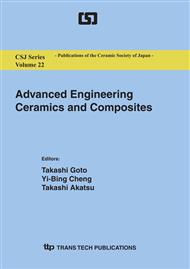p.9
p.15
p.21
p.26
p.32
p.36
p.41
p.46
p.52
Friction Surface Damage of Carbon-Fibre Reinforced Carbon-Silicon Carbide Composites (Cf/C-SiC)
Abstract:
Carbon-fibre reinforced carbon-silicon carbide composites (Cf/C-SiC) has increasingly drawn the attention of designers and engineers of transport vehicles and friction components due to the outstanding combination of low density and high tolerance to mechanical/thermal damage across a wide range of temperatures. However, the lack of enough understanding of tribology and hands-on experience in application could create pitfalls for composites design, and be disappointed in engineering application. Through the study of the friction surface using post-mortem microstructural analysis, we have demonstrated that the friction surface development varies largely from one constituent to another. Friction debris could form a strong bond on the surface of silicon, but unlikely on that of carbon fibre and silicon carbide. Silicon carbide regions could undergo an excessive ductile deformation that led to the development of kinks or microcracks on the friction surface.
Info:
Periodical:
Pages:
32-35
Citation:
Online since:
July 2011
Authors:
Price:
Сopyright:
© 2011 Trans Tech Publications Ltd. All Rights Reserved
Share:
Citation:


